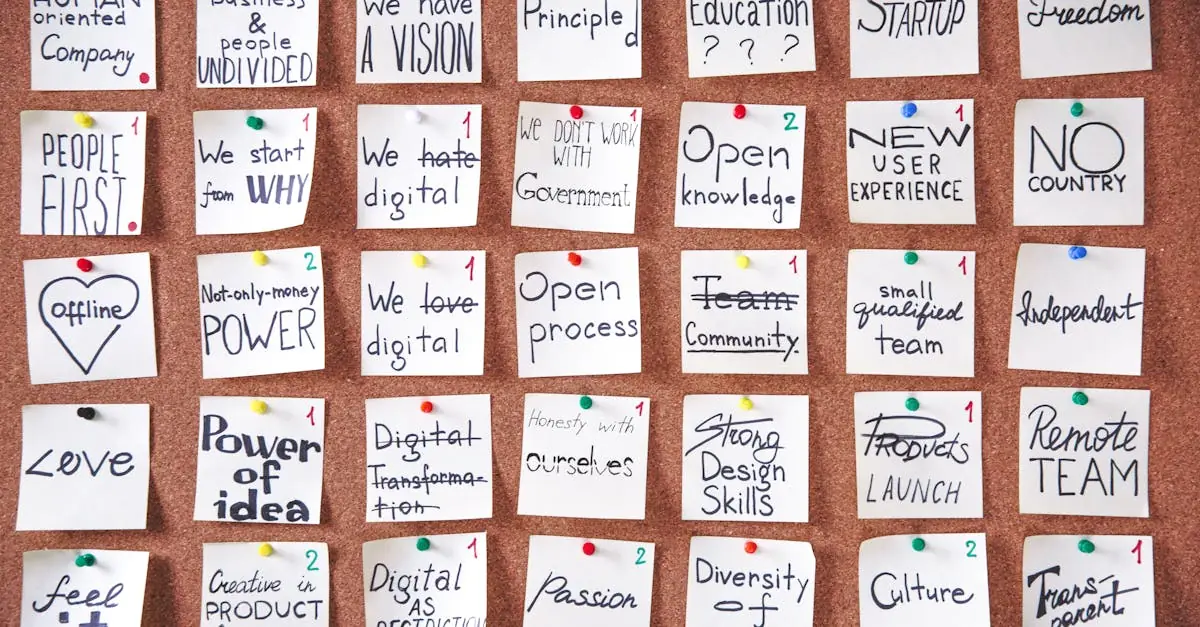Table of Contents
ToggleDesign concepts are the lifeblood of any creative project, but how do you turn a spark of inspiration into a full-blown masterpiece? It’s like trying to bake a soufflé without knowing how to crack an egg—daunting, right? Fear not! Developing design concepts can be a thrilling adventure filled with twists, turns, and maybe a few happy accidents along the way.
Understanding Design Concepts
Design concepts form the foundation of creative projects. Their clear definition and significance shape the overall direction of a design.
Definition of Design Concepts
Design concepts represent a framework that guides the overall aesthetic and functionality of a project. They serve as the initial ideas transformed into tangible representations. Examples include mood boards, sketches, and prototypes. These elements showcase the envisioned style, color palette, and layouts. Developers rely on design concepts to establish unity and coherence throughout the creative process.
Importance of Design Concepts
Design concepts play a crucial role in the success of projects. They aid in visualizing ideas and preventing miscommunication among team members. Strong concepts ensure that the final product aligns with client needs and brand identity. Projects lacking solid design concepts often result in wasted resources and time. Establishing these concepts early enhances the efficiency of the design process while fostering innovation and creativity.
The Design Process
The design process involves systematic stages that transform initial ideas into tangible outcomes. It requires meticulous attention to research, creativity, and collaboration.
Research and Inspiration
Research forms the cornerstone of effective design, driving insight and direction. Designers explore various sources such as books, websites, and industry trends for inspiration. Understanding target audiences shapes design decisions and ensures relevance. Observing competitors aids in identifying gaps and opportunities within the market. Gathering visual elements through mood boards captures the essence of design ideas. Discovering patterns and themes becomes crucial in crafting a compelling narrative within the design concept.
Ideation Techniques
Exploring numerous ideation techniques fosters creativity and innovation. Brainstorming sessions generate a wealth of ideas within a collaborative environment. Techniques like mind mapping encourage connections between concepts, leading to unique design solutions. Sketching serves as a quick way to visualize ideas and iterate on potential designs. Using storyboarding, designers can illustrate the user’s journey and highlight key interactions. Incorporating feedback loops enables continuous improvement, refining concepts based on input from team members and stakeholders.
Developing Your Ideas
Developing design concepts involves multiple stages where creativity and practicality intersect. Designers transform initial ideas through various methods, ensuring every detail aligns with the project goals.
Sketching and Prototyping
Sketching plays an essential role in visualizing ideas. Artists convert abstract thoughts into tangible representations through quick doodles or detailed illustrations. Prototyping follows closely behind, allowing designers to create physical or digital models that communicate functionality and aesthetics clearly. Iterative feedback remains crucial during this phase; each revision enhances the concept’s clarity. Drafting multiple prototypes may reveal unexpected challenges or possibilities. Combining sketches and models ultimately strengthens the connection between initial inspiration and the final outcome.
Selecting Materials and Tools
Choosing the right materials significantly impacts a project’s success. Designers should assess factors like durability, cost, and environmental impact when selecting elements. Tools used in the design process also influence the quality of results; high-quality software or instruments make a difference. Researching appropriate materials enhances understanding, ensuring consistency with the project’s vision. Collaborating with suppliers may uncover innovative options that align with design needs. Prioritizing the right resources ultimately leads to a well-executed outcome that resonates with clients and users alike.
Testing and Refining Concepts
Testing and refining concepts involves validating ideas through real-world applications and feedback. This stage ensures the design aligns with goals and resonates with the target audience.
Gathering Feedback
Gathering feedback from users and stakeholders plays a pivotal role in refining design concepts. Conduct surveys to collect qualitative insights about preferences and pain points. Organize focus groups to observe how various audiences interact with prototypes. Use both formal and informal feedback channels to create a comprehensive understanding of user experiences. Engaging with diverse perspectives helps identify expectations and fosters a collaborative atmosphere. Prioritize actionable feedback to streamline revisions and enhance the design’s effectiveness.
Iteration and Improvement
Iteration and improvement form the backbone of the design process. Begin by refining elements based on feedback and observations. Create multiple versions of a design to explore alternatives, keeping a keen eye on functionality and aesthetics. Use digital tools to facilitate adjustments, making it easier to implement changes quickly. Testing updated concepts with users maintains focus on their needs and expectations. Continuous improvement not only enhances the design’s quality but also cultivates innovation, leading to a final product that resonates deeply with its intended audience.
Finalizing Your Design Concept
Finalizing a design concept involves essential tasks that ensure clarity and cohesion before moving forward. These tasks include creating a presentation and documenting work effectively.
Creating a Presentation
Developing a presentation showcases the design concept to stakeholders. Start by outlining the main ideas and objectives. Utilize visuals like mood boards, sketches, and prototypes to illustrate points. Engaging storytelling plays a vital role in communicating the concept effectively. Tailor the presentation to address audience preferences and expectations. Consider including a timeline that outlines project milestones and deliverables. Inviting questions fosters dialogue and provides valuable insights for refinement.
Documenting Your Work
Documenting the design process ensures a clear record of decisions and changes. Maintain a structured format where each stage of development is logged. Use tools like design journals or digital platforms for easy access and organization. Capturing feedback from team members and stakeholders during this phase offers continual improvement. It’s important to highlight revisions made in response to feedback to demonstrate adaptability. This documentation acts as a reference for future projects, streamlining the development process and maintaining consistency in design philosophy.
Developing design concepts is a journey that blends creativity with structure. By embracing research and collaboration, designers can transform raw ideas into coherent and impactful outcomes. The iterative process of sketching, prototyping, and gathering feedback ensures that concepts align with both client needs and audience expectations.
Fostering a culture of continuous improvement through testing and refinement not only enhances the design but also cultivates innovation. Effective presentations and thorough documentation further solidify the design’s vision and purpose. Ultimately, a well-defined approach to developing design concepts paves the way for successful creative projects that resonate with their intended audience.




